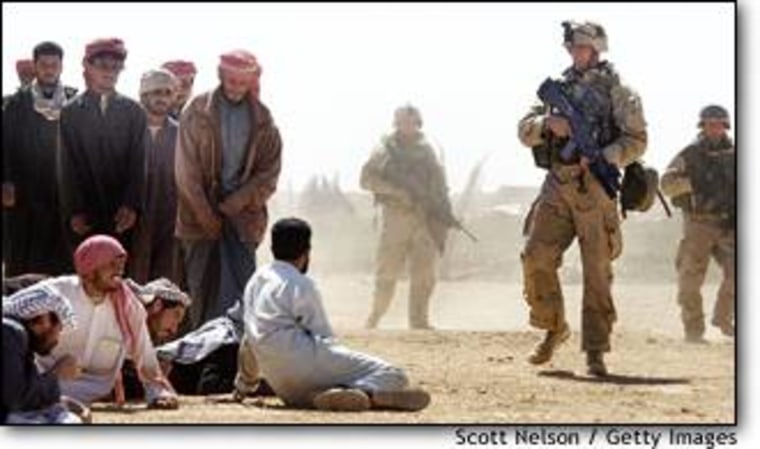Since the war began little more than a week ago, military leaders have gone to great pains to assure the public that the campaign in Iraq is unfolding as planned. Repeated waves of bombing hit Baghdad regularly, destroying key military targets with little collateral damage, and ground troops have made perhaps the fastest ground advance in U.S. military history toward the capital. But it is difficult to understand the tactical or strategic philosophy behind the incredibly small number of troops employed so far in this campaign.
Making its way north along the Euphrates River in the west is the U.S. Army’s 3rd Infantry Division, now barely 50 miles south of Baghdad. Slightly to the east are Marines, who have just crossed the strategic bridges at An Nasiriyah. Farthest to the east are British forces, laboring mightily to deal with Basra and still threatened by local enemy counterattacks as far south as the al-Faw peninsula.
In addition, the 101st Airborne Division is making its way through Iraq, and a portion of the 173rd Airborne Brigade recently landed in northern Iraq to set the stage for a second front.
And that’s about it. Unless the public is being treated to an exceptional misinformation campaign, the coalition is stretched to the limit. There is not enough combat power to achieve the combat mission, control the population and protect the troops.
It does not matter that precision-guided missions may be perfectly precise, which they are not, or that the military may have perfect knowledge of enemy targets, which it does not. In the end, the campaign will only succeed when U.S. and British ground troops defeat Iraqi ground troops and occupy the land.
Given the forces currently at the command of Gen. Tommy Franks, who is directing the war from Central Command headquarters in Qatar, that is not possible. With only two divisions in Iraq and one in reserve, there are no soldiers available to exploit successes, put down major counterattacks, protect interior lines or assault enemy formations along multiple and differing axes.
VULNERABLE POSITIONS
The 3rd Infantry Division, stretched along a thin line following the Euphrates, is particularly vulnerable to isolated attacks on its flanks and a deep spoiling attack that could slice the line in two.
Why?
There is no force securing the rear and permitting the division to shorten its line. In the east, Basra could not be bypassed, even if it were strategically wise, because CENTCOM has no additional force to isolate Basra while the British 7th Armored Brigade skirts the city to advance farther north. If things were to go quickly sour and the 101st had to be committed, there is no way for CENTCOM to reconstitute the reserve from additional forces because there are no additional forces.
Why would CENTCOM enter into a demanding campaign with insufficient forces?
Although the United States was clearly surprised by the refusal of Turkey to permit the basing of U.S. ground troops, U.S. commanders dithered for weeks, waiting for the Turks to change their minds. Evidently, advance elements of the 4th Infantry Division offloaded near Incirlik, waiting for approval to move toward the Iraqi border, then had to re-embark, wasting precious time. There is no doubt that CENTCOM needed the 1st Armored Division and at least one armored cavalry regiment from the very beginning of the ground war, but there is no evidence that any of these assets are yet available.
UNPREPARED FROM THE START
Highly motivated to get the war going quickly, CENTCOM spoke in glowing terms of the technique of having a “rolling start.” This translates into beginning the war with insufficient forces, hoping that a judicious application of strategic air power would compensate for ground combat inadequacy.
While there is little doubt that the coalition will ultimately prevail, this is a dangerous approach whose risk is exacerbated by a policy of trying to avoid collateral damage.
The perfect example of this occurred a few days ago. Apache helicopters south of Baghdad were driven from a target area by enemy soldiers firing individual weapons from the roofs of buildings, but these buildings were not destroyed for fear that there were civilians in them. Thursday night in the British sector, at least four enemy vehicles were sighted, but the local commander, following the rules of engagement, declined to engage them because they were near a hospital.
Undoubtedly, we will see these Iraqi forces again. If that were not enough, the “shock and awe” bombardment of Baghdad has been awesome only to the extent that it seems not to have had a shockingly deleterious effect on the Iraqi defense.
One would think that the military experience of planners would have inculcated the wisdom of applying overwhelming combat power from the very beginning of the conflict. Events thus far demonstrate either that they have forgotten the lesson or that CENTCOM has been overruled by those with less combat experience and a more reckless approach to war.
(Col. Jack Jacobs (U.S. Army retired) is an MSNBC military analyst.)
